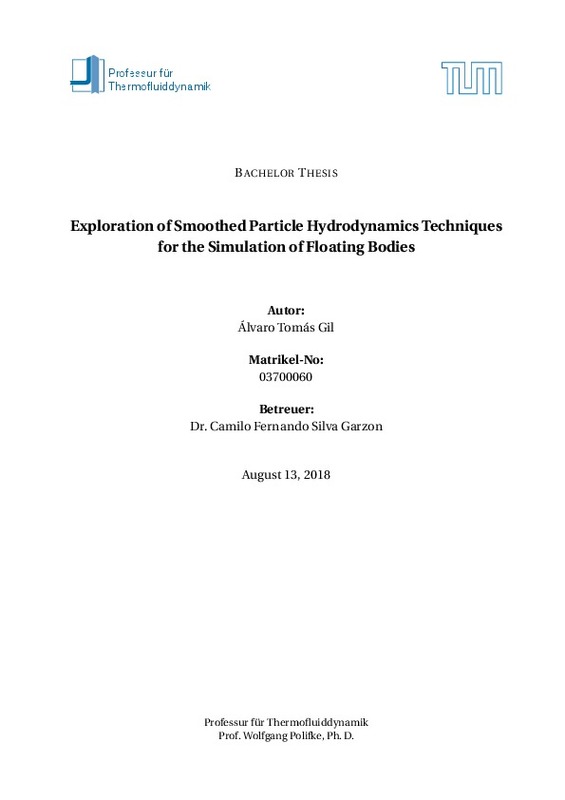JavaScript is disabled for your browser. Some features of this site may not work without it.
Buscar en RiuNet
Listar
Mi cuenta
Estadísticas
Ayuda RiuNet
Admin. UPV
Exploración de técnicas de Smoothed-Particle Hydrodynamics (SPH) para la simulación de cuerpos flotantes
Mostrar el registro sencillo del ítem
Ficheros en el ítem
| dc.contributor.advisor | Cuenca Gotor, Vanesa Paula
|
es_ES |
| dc.contributor.advisor | Silva Garzón, Camilo Fernando
|
es_ES |
| dc.contributor.author | Tomás Gil, Álvaro
|
es_ES |
| dc.date.accessioned | 2020-05-15T09:15:42Z | |
| dc.date.available | 2020-05-15T09:15:42Z | |
| dc.date.created | 2018-09-24 | |
| dc.date.issued | 2020-05-15 | es_ES |
| dc.identifier.uri | http://hdl.handle.net/10251/143368 | |
| dc.description.abstract | [ES] En este trabajo se realiza un estudio sobre las múltiples técnicas de simulación hidrodinámica basada en SPH, un método computacional para la simulación de fluidos basado en la simulación por partículas. Asimismo, se trata de implementar la simulación de una superficie libre de agua expuesta a un cuerpo flotante utilizando las técnicas de este método que se consideran más realistas. Una vez implementada dicha simulación en MATLAB, se lleva a cabo un análisis de los resultados obtenidos, teniendo en cuenta la veracidad de la simulación. | es_ES |
| dc.description.abstract | [EN] The development of any reliable scientific simulation requires physically sound assumptions in order to ensure that the results provided by such simulation tool are as reliable as possible. Otherwise, the utility of the implemented simulation is hindered by the fact that the reality that it recreates does not correspond with the real case under study. Such is the case of implementations of Smoothed Particle Hydrodynamics (SPH) techniques. Although these simulation methods can provide extremely aesthetically pleasing reproductions of fluid movement, it is of considerable significance for the engineer employing these methods to ensure that these recreations are as plausible as possible. In the case of the simulation of a free fluid surface, one can obtain immensely realistic results when correctly employing a Lagrangian scheme such as SPH, partly because in Lagrangian flow fields, the fluid is described by observing the individual motion of a fluid parcel in space and time, thus allowing for a more precise definition of the fluid free surface [2]. This is specially advantageous when compared with Eulerian approaches such as the implementation of the Shallow Water Equations, which require the computation of the free surface elevation of the fluid for every point of the computational domain [22]. In this manner, the objective of this study is to implement a 2D SPH simulation of a free fluid surface interacting with a floating body, and to develop this simulation taking into account the significance of the verisimilitude of the results. The plausibility of the obtained results is observed mainly by analyzing the structure of every component of the simulation structure in contrast with the relevant sources, and by validating the methods employed with a standard case scenario. This report continues by presenting an introduction to the basic principles of SPH and to the basic structure of any SPH Solver, and by further describing and discussing the form that each of the components of the simulation has adopted. Within these descriptions of the elements of the simulation, a special depth will be added to the presentation of the methods of inclusion of the rigid body within the simulation. Later, the results of the simulated cases will be presented and compared. These same results will later be validated by analyzing the resolution of a specific case scenario involving a floating body, in order to end with an evaluation of the study as a whole. | es_ES |
| dc.format.extent | 48 | es_ES |
| dc.language | Inglés | es_ES |
| dc.publisher | Universitat Politècnica de València | es_ES |
| dc.rights | Reserva de todos los derechos | es_ES |
| dc.subject | SPH | es_ES |
| dc.subject | Hidrodinámica | es_ES |
| dc.subject | CFD | es_ES |
| dc.subject | Simulación | es_ES |
| dc.subject | MATLAB | es_ES |
| dc.subject | Flotabilidad | es_ES |
| dc.subject | Partículas | es_ES |
| dc.subject.classification | FISICA APLICADA | es_ES |
| dc.subject.other | Grado en Ingeniería Aeroespacial-Grau en Enginyeria Aeroespacial | es_ES |
| dc.title | Exploración de técnicas de Smoothed-Particle Hydrodynamics (SPH) para la simulación de cuerpos flotantes | es_ES |
| dc.type | Proyecto/Trabajo fin de carrera/grado | es_ES |
| dc.rights.accessRights | Abierto | es_ES |
| dc.contributor.affiliation | Universitat Politècnica de València. Departamento de Física Aplicada - Departament de Física Aplicada | es_ES |
| dc.contributor.affiliation | Universitat Politècnica de València. Escuela Técnica Superior de Ingeniería del Diseño - Escola Tècnica Superior d'Enginyeria del Disseny | es_ES |
| dc.description.bibliographicCitation | Tomás Gil, Á. (2018). Exploración de técnicas de Smoothed-Particle Hydrodynamics (SPH) para la simulación de cuerpos flotantes. Universitat Politècnica de València. http://hdl.handle.net/10251/143368 | es_ES |
| dc.description.accrualMethod | TFGM | es_ES |
| dc.relation.pasarela | TFGM\89312 | es_ES |
Este ítem aparece en la(s) siguiente(s) colección(ones)
-
ETSID - Trabajos académicos [8898]
Escuela Técnica Superior de Ingeniería del Diseño






